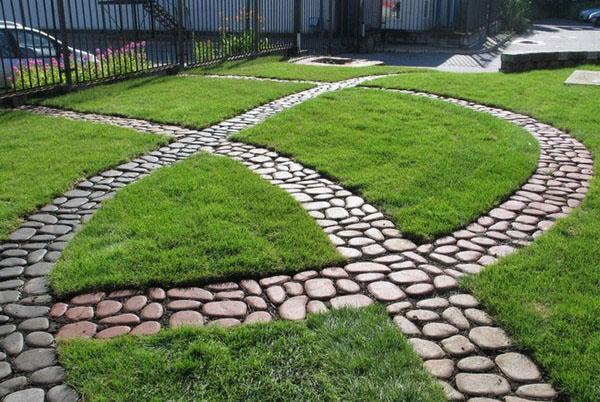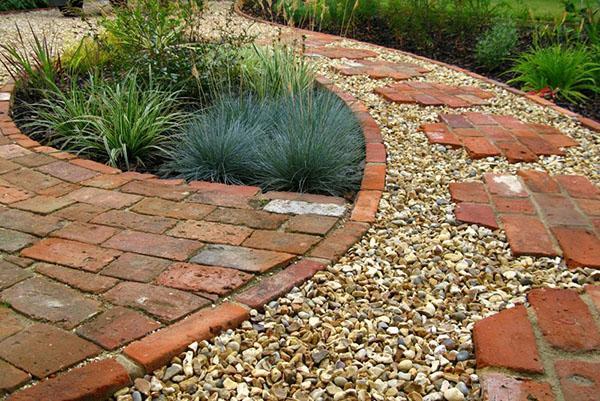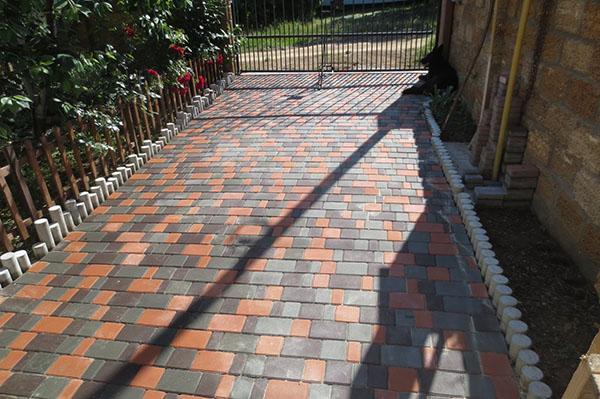Interesting ideas for creating combined paths in the garden
 The usual trampled paths on the site have long since sunk into oblivion. To ennoble the territory of the garden, summer residents lay paths from various materials. They can be made of various materials, which we have already told you about in other reviews. In this article, you will learn about combined paths, which combine several materials and types of paving at once.
The usual trampled paths on the site have long since sunk into oblivion. To ennoble the territory of the garden, summer residents lay paths from various materials. They can be made of various materials, which we have already told you about in other reviews. In this article, you will learn about combined paths, which combine several materials and types of paving at once.

Paving slabs
 Large volume styling paving slabs it is better to entrust a knowledgeable master, however, if you need to install it locally, you can cope on your own, observing the installation technology:
Large volume styling paving slabs it is better to entrust a knowledgeable master, however, if you need to install it locally, you can cope on your own, observing the installation technology:
- First, mark the area with rope and pegs, and then remove a 20 cm layer of soil.
- Crushed stone is poured into the recess, and then tamped.
- We pour sand on top of it and also ram it.
- The next is a layer of cement or dry plaster, which is compacted as much as possible in the same way.
- Now you can start laying the tiles themselves. The cells are placed tightly together and tapped with a rubber mallet.
To eliminate the possibility of weed growth, place geotextiles between the rubble and sand.
Most often, wood is chosen as the second material for combining with paving slabs. It works well for zoning areas and decorating the space between paths. Together with pebbles, the wood-stone pattern looks very fresh and original.
 Recently, they have become fashionable paths from paving slabsthrough which the grass grows. This combination stands out for its uniqueness and simplicity of execution. This is often done by replacing tiles with pebbles or wood.
Recently, they have become fashionable paths from paving slabsthrough which the grass grows. This combination stands out for its uniqueness and simplicity of execution. This is often done by replacing tiles with pebbles or wood.
Combination options with concrete
 Typically, concrete is used to create large monolithic structures. It looks inconspicuous and boring if you fill the entire area of the track with it. It should also be borne in mind that in regions with severe frosts, concrete is not the best choice, as it can crack.
Typically, concrete is used to create large monolithic structures. It looks inconspicuous and boring if you fill the entire area of the track with it. It should also be borne in mind that in regions with severe frosts, concrete is not the best choice, as it can crack.
 The appearance of concrete slabs is completely transformed when combined with pebbles, wild stone or lush grass. Make sections of different lengths by adding special dyes and broken tiles for decoration. There are also special forms that are installed in the right places and then filled with mortar.
The appearance of concrete slabs is completely transformed when combined with pebbles, wild stone or lush grass. Make sections of different lengths by adding special dyes and broken tiles for decoration. There are also special forms that are installed in the right places and then filled with mortar.
Wild stone
 Wild stone is ideal for those looking for maximum naturalness. It looks good both alone and in combination with pebbles, tiles or grass. Thanks to the rough surface, you will not slip on the stone even in rainy weather. As a rule, it is laid on mortar, although some place flagstone on sand. Note that this will be less reliable.
Wild stone is ideal for those looking for maximum naturalness. It looks good both alone and in combination with pebbles, tiles or grass. Thanks to the rough surface, you will not slip on the stone even in rainy weather. As a rule, it is laid on mortar, although some place flagstone on sand. Note that this will be less reliable.
Pebbles
 Pebble paving is an excellent solution for the design of a combined path. In addition to its excellent compatibility with other materials, it has a positive effect on human health if you regularly walk on it barefoot.
Pebble paving is an excellent solution for the design of a combined path. In addition to its excellent compatibility with other materials, it has a positive effect on human health if you regularly walk on it barefoot.
 At first glance, the simplicity of the design, in fact, translates into a painstaking and complex process of digging a depression, and preparing a sand-crushed stone pillow by analogy with paving slabs.Then the pebbles are placed on the mortar.
At first glance, the simplicity of the design, in fact, translates into a painstaking and complex process of digging a depression, and preparing a sand-crushed stone pillow by analogy with paving slabs.Then the pebbles are placed on the mortar.
Any track requires a curb. Do not neglect installing it as it will give a unique look to the entire composition. It is worth the effort and expense.
What is good about gravel and crushed stone
 The main advantage of bulk material is ease of installation. In addition, special skills are not required to create such a track. Crushed stone and granite chips of different colors look great in combination with wood flooring and tile borders.
The main advantage of bulk material is ease of installation. In addition, special skills are not required to create such a track. Crushed stone and granite chips of different colors look great in combination with wood flooring and tile borders.
 To make such a path, it is enough to dig a depression, lay materials from weeds and cover it with rubble on top. As a minus of bulk paths, it is possible to note the need to periodically trim them.
To make such a path, it is enough to dig a depression, lay materials from weeds and cover it with rubble on top. As a minus of bulk paths, it is possible to note the need to periodically trim them.
Wood cuts
 This extremely popular option looks cozy and beautiful. In combination with stone chips, wooden sections look great. However, despite the fact that all wooden surfaces are treated with solutions against moisture, they quickly deteriorate and become covered with moss in those regions where there is constant moisture.
This extremely popular option looks cozy and beautiful. In combination with stone chips, wooden sections look great. However, despite the fact that all wooden surfaces are treated with solutions against moisture, they quickly deteriorate and become covered with moss in those regions where there is constant moisture.
The optimal solution in such conditions would be the choice of materials designed "like wood", for example, some types of tiles.
 In conclusion, 2 important nuances should be noted. First, whichever track you choose, it should be located about 5 cm above the ground to avoid excessive pollution during precipitation. Secondly, observe the angle of inclination towards the curb for water outflow. Use our tips for creating combined tracks and amaze your friends with the original design of your site.
In conclusion, 2 important nuances should be noted. First, whichever track you choose, it should be located about 5 cm above the ground to avoid excessive pollution during precipitation. Secondly, observe the angle of inclination towards the curb for water outflow. Use our tips for creating combined tracks and amaze your friends with the original design of your site.